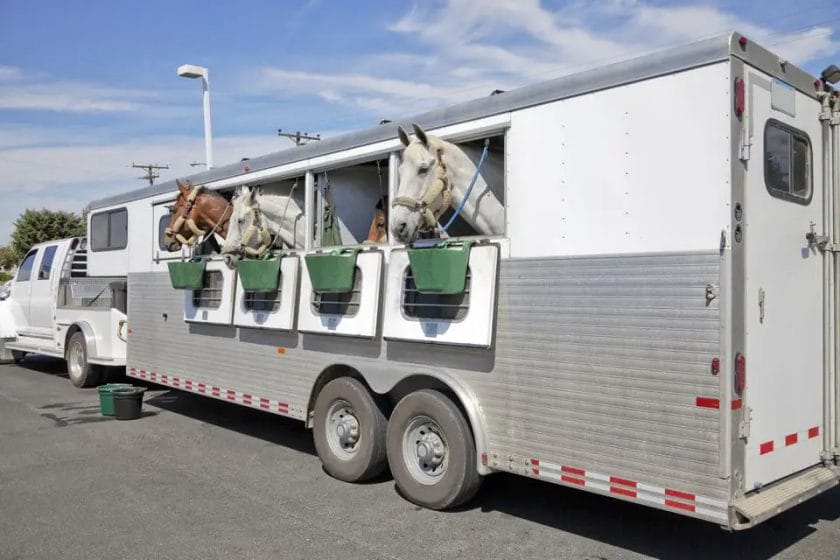A horse can typically be in a trailer for several hours at a time, depending on the distance and the horse’s overall condition. It is important to ensure that the horse has enough space to move around and can stand comfortably during the journey. Additionally, regular breaks should be provided to allow the horse to stretch its legs and relax. Careful monitoring of the horse’s well-being, temperature, and hydration levels is crucial throughout the journey.

Factors to Consider: Key factors affecting the duration a horse can spend in a trailer
Transporting horses in trailers is a common practice for horse owners and trainers. Whether it’s for a short trip to a local show or a long-distance journey, ensuring the safety and well-being of the horses during transportation is of utmost importance. The duration a horse can spend in a trailer depends on several key factors that need to be considered to ensure their comfort and minimize any potential risks.
1. Trailer Size and Design
The size and design of the trailer play a crucial role in determining how long a horse can comfortably travel. A trailer should be spacious enough for the horse to stand, turn around, and maintain its balance during the journey. It should also have adequate ventilation to prevent overheating or respiratory issues. Additionally, a trailer with a smooth and stable ride will help minimize stress and discomfort for the horse.
2. Temperature and Weather Conditions
The temperature and weather conditions both inside and outside the trailer can significantly impact the duration a horse can spend inside. Horses are more prone to heat stress, dehydration, and respiratory issues in hot and humid weather. Similarly, extreme cold temperatures can lead to discomfort and increase the risk of hypothermia. It is essential to monitor the temperature inside the trailer and make necessary adjustments to ensure the horse’s well-being.
3. Rest and Breaks
Providing horses with regular rest and breaks during long journeys is crucial to their physical and mental well-being. Horses need time to stretch their legs, relax, and relieve themselves. It is recommended to stop every few hours and allow the horse to rest outside the trailer. This not only helps prevent fatigue and stiffness but also reduces stress and anxiety associated with prolonged confinement.
4. Water and Food Availability
Access to fresh water and food is vital for horses during transportation. Dehydration can be a significant concern, especially during long trips. It is essential to ensure that the horse has access to clean water at regular intervals. Similarly, providing small amounts of hay or feed during breaks can help keep the horse’s digestive system functioning properly and prevent discomfort.
5. Trailer Loading and Unloading
The loading and unloading process can significantly impact the horse’s willingness to stay in the trailer for an extended period. Proper training and familiarization with the loading process can help reduce stress and anxiety. Using appropriate safety measures, such as non-slip flooring and secure partitions, can also provide the horse with stability and prevent injuries during transit.
6. Stress and Comfort
Horses are sensitive animals, and their stress levels can impact their overall well-being during transportation. Minimizing stressors, such as loud noises, sudden movements, or overcrowding in the trailer, is essential for a smooth and comfortable journey. Providing familiar bedding or using calming aids, such as soothing music or natural remedies, can also help reduce anxiety and promote relaxation.
7. Health and Fitness
The horse’s health and fitness levels play a significant role in determining how long they can comfortably spend in a trailer. Horses with underlying health issues or fitness limitations may require shorter travel durations or additional care during transportation. Regular veterinary check-ups and appropriate conditioning programs can help ensure the horse’s physical well-being and readiness for travel.
8. Experience and Training
Horses that have previous positive experiences with trailer travel and are well-trained are more likely to tolerate longer durations inside the trailer. Introducing horses to trailer training gradually, using positive reinforcement techniques, can help build their confidence and familiarity. Additionally, regular practice sessions can help desensitize them to potential stressors and improve their overall travel behavior.
In summary, the duration a horse can spend in a trailer depends on various factors that need to be carefully considered. Ensuring the right trailer size and design, monitoring temperature and weather conditions, providing regular rest and breaks, offering access to water and food, implementing proper loading and unloading procedures, minimizing stress, and maintaining the horse’s health and fitness are all key elements in ensuring a safe and comfortable journey for the horse.

Trailer Size and Design: Impact on Horse Transportation
When it comes to transporting horses, the size and design of the trailer play a crucial role in ensuring the comfort and safety of the animal. The duration for which a horse can be comfortably transported greatly depends on these factors. Let’s explore how trailer size and design can impact horse transportation.
1. Space and Comfort
The size of the trailer directly affects the space available for the horse during transportation. A cramped trailer can cause stress and discomfort to the horse, making the journey unpleasant. On the other hand, a spacious trailer allows the horse to move freely and find a comfortable position, reducing the chances of fatigue and injury.
Additionally, the design of the trailer can contribute to the horse’s comfort. Well-designed trailers may include features such as adjustable partitions, padded walls, and flooring, which provide stability and cushioning during transit.
2. Ventilation and Airflow
Adequate ventilation is essential to maintain a healthy environment inside the trailer. Poor airflow can lead to the accumulation of dust, ammonia, and other harmful substances, causing respiratory issues for the horse. A well-ventilated trailer with windows or vents allows fresh air to circulate, reducing the risk of respiratory problems during transportation.
3. Safety and Stability
The design of the trailer should prioritize the safety and stability of the horse. Features such as secure partitions, non-slip flooring, and proper suspension systems help minimize the risk of accidents and injuries. Additionally, trailers with low centers of gravity and well-balanced axles provide better stability, reducing the chances of tipping or swaying during transit.
4. Loading and Unloading
The size and design of the trailer can also impact the ease of loading and unloading the horse. A trailer with a suitable height and width allows for smooth entry and exit of the horse, minimizing stress and potential injuries. Ramps or step-up designs can make it easier for the horse to navigate the trailer, particularly for older or injured animals.
5. Long Distance Transportation
For long-distance transportation, trailer size and design become even more important. A larger trailer provides space for the horse to stretch its legs and rest during breaks. The ability to customize the interior layout and storage compartments in larger trailers also allows for the transportation of additional supplies and equipment, ensuring the horse’s wellbeing throughout the journey.
In summary, the size and design of a horse trailer have a significant impact on the duration a horse can be comfortably transported. It is crucial to provide adequate space, ventilation, safety measures, and easy loading/unloading options to ensure the horse’s well-being during transit. Taking into account these factors will help create a positive and stress-free travel experience for both the horse and the owner.

Proper Ventilation and Temperature Control: Importance for the Well-being of Horses during Transport
Transporting horses can be a stressful experience for these majestic animals. It is crucial to ensure their well-being and comfort during the journey. One of the key factors that greatly affect their safety and health is proper ventilation and temperature control.
When horses are being transported, they are confined to a limited space, such as a trailer or a horsebox. Without adequate ventilation, the air inside can become stale and lack oxygen, leading to respiratory issues and discomfort. Proper ventilation ensures a constant flow of fresh air, removing any harmful pollutants, dust, or excess moisture that may accumulate.
In addition to ventilation, maintaining an optimal temperature is vital for the well-being of horses during transport. Horses are sensitive to extreme temperatures, and being exposed to excessive heat or cold can have detrimental effects on their health. High temperatures can cause heat stress, dehydration, and even heat stroke, while extreme cold can lead to hypothermia and frostbite.
The Importance of Ventilation
Ventilation plays a critical role in ensuring a comfortable and safe environment for horses during transport. Here are some reasons why proper ventilation is essential:
- Improved Air Quality: Good ventilation helps remove dust, mold, and airborne particles that can irritate a horse’s respiratory system. This reduces the risk of respiratory conditions like allergies, bronchitis, or pneumonia.
- Reduced Heat Build-up: Ventilation allows for the removal of excess heat produced by horses during transport. This prevents the trailer or horsebox from becoming too hot, reducing the risk of heat stress or heat-related illnesses.
- Elimination of Odors: Adequate ventilation helps dissipate odors that may accumulate in an enclosed space. This keeps the air fresh and prevents the buildup of ammonia from urine, which can be harmful to horses’ respiratory health.
- Prevention of Condensation: Proper airflow helps prevent condensation inside the trailer or horsebox. Condensation can lead to a damp environment, increasing the chances of respiratory infections and discomfort for the horses.
The Importance of Temperature Control
Temperature control is equally important when transporting horses. Here’s why maintaining optimal temperatures is vital:
- Avoiding Heat-related Illnesses: Horses are prone to heat stress, especially during hot summer months or long journeys. Adequate temperature control, such as using fans or air conditioning, helps prevent overheating and the associated risks.
- Preventing Hypothermia: In colder climates or during winter, horses are at risk of developing hypothermia if exposed to low temperatures for extended periods. Insulating the trailer and providing appropriate bedding can help maintain a comfortable temperature for the horses.
- Reducing Stress and Anxiety: Extreme temperatures can increase the stress and anxiety levels of horses during transport. By maintaining a comfortable temperature, horses are more likely to remain calm and relaxed throughout the journey.
- Promoting Overall Well-being: When horses are transported in a controlled temperature environment, their immune system remains strong, reducing the risk of illnesses and ensuring their overall well-being.
In summary, proper ventilation and temperature control are crucial for the well-being of horses during transport. Adequate ventilation ensures a fresh and healthy environment, while temperature control helps prevent heat stress or hypothermia. By prioritizing these factors, horse owners and transporters can ensure a safe and comfortable journey for these magnificent creatures.
Health and Well-being: Tips for Ensuring the Health and Well-being of Horses During Long Trailer Journeys
Traveling long distances in a trailer can be stressful for horses, but with proper care and attention, you can ensure their health and well-being throughout the journey. Here are some essential tips to consider:
1. Prepare the Trailer
Prior to the journey, it is crucial to inspect and prepare the trailer to provide a safe and comfortable environment for your horse. Check the flooring for any damage or wear and make sure it is clean and non-slippery. Ensure that the ventilation system is working correctly to provide fresh air circulation.
2. Make Proper Arrangements
Plan your trip strategically to minimize travel time and avoid extreme weather conditions. Choose a route with well-maintained roads and rest stops where you can take breaks and allow your horse to stretch their legs. It is advisable to travel during cooler hours of the day to prevent overheating.
3. Hydration and Nutrition
Keep your horse adequately hydrated throughout the journey by offering fresh water at regular intervals. Consider using water buckets or automatic waterers that are secured in a way that prevents spilling. Provide hay or other forage in a hay net or rack to keep your horse occupied and maintain their digestive health.
4. Monitor Temperature and Humidity
Monitor the temperature and humidity levels inside the trailer during the journey. Ensure that the trailer is well-ventilated and equipped with fans to maintain a comfortable environment. Avoid extreme temperature fluctuations that can cause stress and discomfort to your horse.
5. Reduce Stress and Anxiety
Trailer rides can be stressful for horses, so taking measures to reduce their anxiety is essential. Use calming techniques such as playing soothing music or using calming supplements, if necessary. Familiarize your horse with the trailer before the journey and ensure that they are comfortable loading and unloading.
6. Regular Breaks and Exercise
During long trailer journeys, it is crucial to take regular breaks to allow your horse to rest and relax. Stop at designated rest areas or suitable locations where you can unload your horse and let them stretch their legs. This will help prevent stiffness and muscle fatigue.
7. Regular Monitoring
Keep a close eye on your horse throughout the journey. Monitor their behavior, breathing, and overall well-being. Check for any signs of distress, such as excessive sweating or rapid breathing. If you notice any concerns, consult a veterinarian immediately.
8. First Aid Kit and Emergency Contacts
Always carry a well-stocked first aid kit specifically designed for horses. Include essential items such as bandages, antiseptic ointment, and medications prescribed by your veterinarian. Keep a list of emergency contact numbers, including your regular veterinarian and local veterinary hospitals along the route.
9. Post-Journey Care
Once you reach your destination, provide your horse with a comfortable resting area and access to water and forage. Allow them ample time to recover from the journey and monitor their condition closely. If any issues arise, seek veterinary assistance promptly.
In summary, ensuring the health and well-being of horses during long trailer journeys requires careful planning and attention to their needs. By preparing the trailer, providing proper hydration and nutrition, managing temperature and humidity, reducing stress, allowing regular breaks and exercise, monitoring their well-being, and being prepared for emergencies, you can make the journey as safe and comfortable as possible for your horse.
FAQs
How long can a horse be in a trailer?
The maximum recommended duration for a horse to be in a trailer is 8-10 hours. However, it is important to provide regular rest stops to allow the horse to stretch its legs, hydrate, and relieve itself. Longer journeys should be broken up into multiple days to ensure the horse’s well-being.
Conclusion
In conclusion, the duration a horse can safely be in a trailer varies depending on several factors. It is important to prioritize the well-being and comfort of the horse during transportation. Adequate ventilation, proper temperature control, and regular breaks are essential to prevent stress and fatigue.
Additionally, horses should have enough space to stand, lie down, and turn around comfortably. Long journeys may require overnight stops to allow for rest and recovery. It is crucial to adhere to transportation guidelines and consult with equine experts for best practices.
Remember, ensuring the horse’s safety and welfare should always be the top priority.
